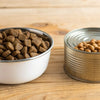Should I Feed My Dog Dry Food? Exploring the Pros and Cons of Canine Nutrition
- Houndsy
Table of Contents
- Introduction
- Understanding Your Dog’s Nutritional Needs
- The Case for Dry Dog Food
- Potential Drawbacks of Dry Dog Food
- The Benefits of Wet and Fresh Foods
- The Mixed Feeding Approach
- Choosing the Right Dry Dog Food
- Conclusion
Introduction
Have you ever wondered what the best diet is for your furry friend? Recent studies reveal that nearly 60% of dogs are overweight or obese, leading to various health complications. As responsible pet owners, we want to ensure our dogs receive the nutrition they need to thrive. One of the most pressing questions we face is, “Should I feed my dog dry food?”
In this blog post, we’ll explore the nuances of dog nutrition, focusing specifically on dry food versus its alternatives. We’ll discuss the nutritional needs of dogs, the benefits and drawbacks of dry food, and how to make informed feeding choices that enhance your dog’s well-being. By the end, you’ll have a comprehensive understanding of whether dry food is the right choice for your canine companion.
Let’s dive into the world of canine nutrition, examine the factors influencing your dog’s dietary requirements, and reflect on your own feeding routines as we provide clarity on this essential topic.
Understanding Your Dog’s Nutritional Needs
Before deciding if dry food is the best option for your dog, it's crucial to understand their nutritional needs, which can vary based on several factors:
Age and Size
Puppies, adults, and senior dogs all have different dietary requirements. For instance, growing puppies require higher protein and fat levels to support their rapid development, while seniors may need fewer calories and more fiber to maintain a healthy weight and digestive health.
Activity Level
A highly active dog, such as a working or sporting breed, requires more calories and higher protein levels than a more sedentary companion. Adjusting your dog's diet based on their energy expenditure is essential for maintaining optimal health.
Health Conditions
Dogs with specific health issues, such as kidney problems or food allergies, may require specialized diets. Consulting with a veterinarian can help determine the best nutritional approach for your pet's unique needs.
Lifestyle
Your lifestyle also plays a role in your feeding choices. Busy pet owners may prefer the convenience of dry food, while those who have more time might opt for fresh or wet food options.
The Case for Dry Dog Food
Dry dog food, often referred to as kibble, has gained popularity among pet owners due to its convenience and affordability. Here are some key benefits of feeding your dog dry food:
1. Dental Health Benefits
One of the most significant advantages of dry food is its potential to support dental health. The texture of kibble encourages dogs to chew, which can help reduce plaque buildup and promote healthier gums. Regular chewing can also assist in cleaning your dog’s teeth, reducing the risk of periodontal disease.
2. Convenience and Storage
Dry food is easy to store and convenient to serve. It doesn’t spoil as quickly as wet food, making it ideal for busy pet owners. You can pre-portion meals into containers or use automatic feeders, such as the Houndsy Kibble Dispenser, which ensures your dog gets the right amount of food at the right time while maintaining a clean feeding area.
3. Cost-Effectiveness
In general, dry food is more economical than wet or fresh food options. It has a longer shelf life, reducing waste and allowing you to save money in the long run.
4. Controlled Caloric Intake
With dry food, it's easier to monitor your dog's caloric intake, preventing overfeeding. This is especially beneficial for dogs prone to obesity, as you can accurately measure out their portions.
5. Nutritional Balance
High-quality dry dog foods are designed to provide a complete and balanced diet, containing essential nutrients like protein, fats, vitamins, and minerals. When selecting dry food, look for products that meet AAFCO standards to ensure your dog receives adequate nutrition.
Potential Drawbacks of Dry Dog Food
While dry food has several benefits, it’s essential to consider its potential downsides:
1. Moisture Content
Dry food typically contains around 10% moisture, which can lead to dehydration if your dog doesn’t drink enough water. If your dog is prone to urinary issues or doesn't drink enough throughout the day, this could be a concern.
2. Palatability
Some dogs may find dry food less palatable than wet food or fresh options. If your dog is a picky eater, you might need to experiment with different brands or consider mixing in wet food or adding a small amount of broth to enhance flavor.
3. Processing Concerns
Many dry foods undergo extensive processing, which may involve high heat that can strip away some nutrients. Look for brands that prioritize high-quality ingredients and minimal processing.
4. Additives and Fillers
Some lower-quality dry foods contain fillers, artificial preservatives, and by-products that may not contribute to your dog’s health. Always read ingredient labels and choose brands that use wholesome, natural ingredients.
The Benefits of Wet and Fresh Foods
While dry food has its advantages, wet and fresh dog foods offer unique benefits as well. Here’s a brief overview of why some pet owners opt for these alternatives:
1. Hydration
Wet food contains significantly more moisture (up to 78%), which can help keep your dog hydrated, particularly if they’re reluctant to drink water. This is particularly important for dogs with kidney issues or those prone to urinary tract infections.
2. Increased Palatability
Many dogs find wet food more appealing due to its rich aroma and flavor. This can be particularly beneficial for older dogs, those recovering from illness, or picky eaters who may be more likely to eat if the food is more enticing.
3. Variety in Diet
Feeding a combination of wet and dry food can provide a well-rounded diet that meets various nutritional needs and keeps mealtime exciting. Mixing the two can help ensure your dog receives the benefits of both food types.
4. Ease of Digestion
Wet and fresh foods can be easier to digest for some dogs, especially those with dental issues or gastrointestinal sensitivities. The softer texture may be more suitable for dogs that have trouble chewing kibble.
The Mixed Feeding Approach
For many pet owners, choosing between dry food and wet food doesn’t have to be an either/or decision. A mixed feeding approach can provide the best of both worlds. Here’s how to implement this method effectively:
1. Calculate Caloric Needs
Consult with your veterinarian to determine your dog’s daily caloric needs based on their age, weight, and activity level.
2. Portion Control
Once you have an understanding of your dog’s caloric requirements, you can divide their meals between dry and wet food. Be sure to adjust portions accordingly to prevent overfeeding.
3. Monitor Your Dog’s Health
Keep an eye on your dog’s weight, coat condition, and overall health as you transition to a mixed feeding regimen. If you notice any changes, consult your veterinarian for guidance.
4. Experiment with Combinations
Try different combinations of dry and wet food to find what your dog enjoys the most. You might discover that certain ratios work better for your canine companion.
Choosing the Right Dry Dog Food
If you decide to feed your dog dry food, selecting a high-quality brand is crucial. Here are some tips for choosing the right dry food:
1. Read the Ingredients
Look for a dry food that lists a high-quality protein source as the first ingredient. Avoid products with vague terms like “meat by-products” or “animal fat.”
2. Check for AAFCO Approval
Ensure that the dog food meets AAFCO (Association of American Feed Control Officials) guidelines for complete and balanced nutrition.
3. Consider Your Dog’s Specific Needs
Choose a formula tailored to your dog’s life stage (puppy, adult, senior) and any specific health requirements they may have.
4. Avoid Fillers and Artificial Additives
Select foods that are free from artificial preservatives, colors, and low-quality fillers. Natural ingredients are always preferable for your dog's health.
Conclusion
In summary, deciding whether to feed your dog dry food involves considering their unique needs, lifestyle, and preferences. While dry food offers numerous benefits, including convenience and dental health advantages, it’s essential to weigh these against potential downsides, such as moisture content and palatability.
Ultimately, the best approach may include a combination of dry and wet food to provide a well-rounded diet that meets your dog’s nutritional requirements while keeping mealtime enjoyable.
As you reflect on your feeding choices, consider exploring our Houndsy Kibble Dispenser to simplify your feeding routine and ensure your dog enjoys perfectly portioned meals every time. With its elegant design and functionality, it’s a beautiful addition to your home that enhances the feeding experience.
For more information on how to elevate your dog’s feeding ritual, check out our Houndsy Kibble Dispenser today!
FAQ
1. Can I mix dry and wet dog food?
Yes! Mixing dry and wet dog food can provide a balanced diet. Just make sure to calculate the total caloric intake to avoid overfeeding.
2. How do I know if my dog is overweight?
You can assess your dog's weight by checking their body condition score. A healthy dog should have a visible waist and their ribs should be easily felt but not visible.
3. Is dry food better than wet food for dogs?
It depends on your dog's specific needs. Dry food offers dental benefits and convenience, while wet food provides hydration and palatability. A mixed approach can be beneficial.
4. What should I look for in dog food?
Look for high-quality protein sources, whole ingredients, and AAFCO approval. Avoid fillers and artificial additives for optimal nutrition.
5. How often should I feed my dog?
Most adult dogs benefit from being fed twice a day, while puppies may require three to four meals. Adjust based on your dog’s age, size, and activity level.













